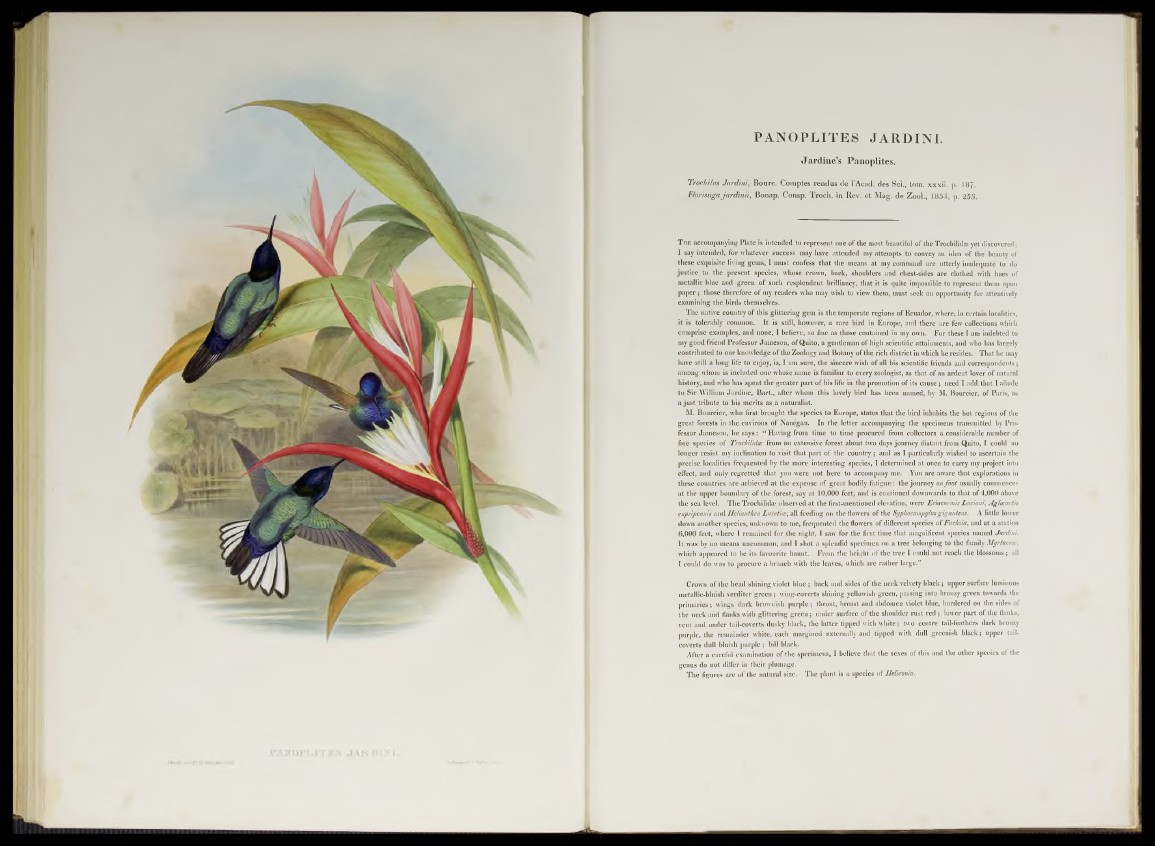
PANOPLITES JARDINI.
Ja rd in e ’s Panoplites.
Trochilus Jardini, Bourc. Comptes rendas de 1’Acad. des Sci., tom. xxxii. p. 187.
F/orisugct jardinii, Bonap. Consp. Troeh. in Rev. et Mag. de Zool., 1854, p. 253.
T he accompanying P late is intended to represent one o f the most beautiful of the Trochilidae yet discovered;
I say intended, for vvhatever success may have attended my attempts to convey an idea of the beauty of
these exquisite living gems, I must confess that the means at my command are utterly inadequate to do
justice to the present species, whose crown, back, shoulders and chest-sides are clothed with hues of
metallic blue and green of such resplendent brilliaucy, that it is quite impossible to represent them upon
paper; those therefore of my readers who may wish to view them, must seek an opportunity for attentively
examining the birds themselves.
The native country of this glittering gem is the temperate regions of Ecuador, where, in certain localities,
it is tolerably common. It is still, however, a rare bird in Europe, and there are few collections which
comprise examples, and none, I believe, so fine as those contained in my own. For these I am indebted to
my good friend Professor Jameson, of Quito, a gentleman of high scientific attainments, and who has largely
contributed to our knowledge of the Zoology and Botany of the rich district in which he resides. That he may
have still a long life to enjoy, is, I am sure, the sincere wish of all bis scientific friends and correspondents;
among whom is included one whose name is familiar to every zoologist, as that of an ardent lover of natural
history, and who has spent the greater part of his life in the promotion of its cause ; need I add that I allude
to Sir William Jardine, Bart., after whom this lovely bird has been named, by M. Bourcier, of Paris, as
a just tribute to his merits as a naturalist.
M. Bourcier, who first brought the species to Europe, States that the bird inhabits the hot regions of the
great forests in the environs of Nanégan. In the letter accompanying the specimens transmitted by Professor
Jameson, he says: “ Having from time to time procured from collectors a considerable number of
fine species of Trochïlidce from an extensive forest about two days journey distant from Quito, I could no
longer resist my inclination to visit that part of the country ; and as I particularly wished to ascertain the
precise localities frequented by the more interesting species, I determined at once to carry my project into
effect, and only regretted that you were not here to accompany me. You are aware that explorations in
these countries are achieved at the expense of great bodily fatigue: the journey on foot usually commences
at the upper boundary of the forest, say at 10,000 feet, and is continued downwards to that of 4,000 above
the sea level. The Trochilidae observed at the first-mentioned elevation, were Eriocnemis Luciani, Aglceactis
cupripennis and Helianthea Lutetice, all feeding on the flowers of the Syphocampylus giganteus. A little lower
down another species, unknown to me, frequented the flowers of different species of Fuchsia, and at a station
6,000 feet, where I remained for the night, I saw for the first time that magnificent species named Jardini.
It was by no means uncommon, and I shot a splendid specimen on a tree belonging to the family Myrtacece,
which appeared to be its favourite haunt. From the height of the tree I could not reach the blossoms; all
I could do was to procure a branch with the leaves, which are rather large.”
Crown of the head shining violet blue ; back and sides of the neck velvety black; upper surface luminous
metallic-bluish verditer green; wing-coverts shining yellowish green, passing into bronzy green towards the
primaries; wings dark brownish purple; throat, breast and abdomen violet blue, bordered on the sides of
the neck and flanks with glittering green; under surface of the shoulder rust red ; lower part of the flanks,
vent and under tail-coverts dusky black, the latter tipped with white; two centre tail-feathers dark bronzy
purple, the remainder white, each inargined externally and tipped with dull greenish black; upper tail-
coverts dull bluish purple ; bill black.
After a careful examination of the specimens, I believe that the sexes of this and the other species of the
genus do not differ in their plumage.
The figures are of the natural size. The plant is a species of Heliconia.